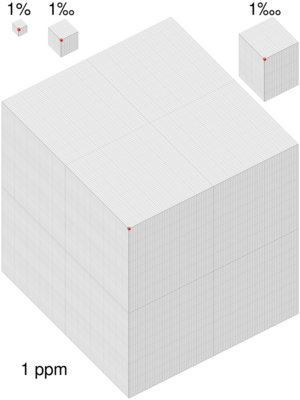Percentage facts for kids
A percentage is a special way to show a part of a whole thing. It's like saying "how many out of every 100." We use the percent sign (%), like in "50%", to show it. Percentages help us compare things easily, like how much of something there is compared to the total.
Contents
What are Percentages?
A percentage tells you how much of something there is for every 100.
- For example, 45% means 45 out of 100. You can also write this as a fraction (45100) or a decimal (0.45).
- Percentages are great for showing a part of a total amount.
Simple Examples
Example 1: Students in a Class
If 50% of the students in a class are boys, it means that for every 100 students, 50 are boys. If there are 500 students in total, then 250 of them are boys (because 50% of 500 is 250).
Example 2: Price Increase
Imagine a toy costs $2.50. If its price goes up by $0.15, that's a small part of the original price. To find the percentage increase, you divide the increase ($0.15) by the original price ($2.50).
- 0.152.50 = 0.06
- To turn 0.06 into a percentage, you multiply it by 100. So, 0.06 × 100 = 6%. This means the price went up by 6%.
Percentages usually range from 0 to 100, but they can be higher or even negative! For example, if something grows a lot, it might be 111%. If something decreases, it could be -35%.
History of Percentages
Long ago, even before we had our current number system, people in Ancient Rome used calculations similar to percentages. They often worked with fractions that were parts of 100. For example, the Roman emperor Augustus once put a tax of 1100 on goods sold at auctions. This was like a 1% tax!
As money became more common in the Middle Ages, using 100 as a base for calculations became very popular. By the 1600s, it was normal to talk about interest rates (how much extra money you pay back on a loan) in terms of hundredths.
The Percent Sign (%)
The word "percent" comes from the Latin words per centum, which means "by the hundred."
The symbol we use for percent, the %, came from the Italian words per cento, meaning "for a hundred." Over time, the "per" part was shortened to "p." and then disappeared. The "cento" part was squished into two circles with a line between them, which became our modern % symbol.
How to Calculate Percentages
To find a percentage, you take the part you're interested in, divide it by the total amount, and then multiply the answer by 100.
- For example, if you have 50 apples out of 1,250 apples, you first divide 50 by 1,250: 501250 = 0.04.
- Then, you multiply 0.04 by 100 to get 4%. So, 50 apples are 4% of 1,250 apples.
Percentage of a Percentage
Sometimes you need to find a percentage of another percentage. To do this, you change both percentages into decimals or fractions and then multiply them.
- For example, to find 50% of 40%:
* Change 50% to 0.50 (or 50100). * Change 40% to 0.40 (or 40100). * Multiply them: 0.50 × 0.40 = 0.20. * Change 0.20 back to a percentage: 0.20 × 100 = 20%. * So, 50% of 40% is 20%.
It's important to always be clear about what your percentage is referring to. What is the "total" that equals 100%?
Example: College Majors
Let's say in a college:
- 60% of all students are girls.
- 10% of all students study computer science.
- 5% of the girl students study computer science.
We want to know: What percentage of computer science students are girls? 1. First, find out what percentage of all students are girls who study computer science. * 60% of all students are girls, and 5% of those girls study computer science. * So, 60100 × 5100 = 3100 or 3% of all students are girls who study computer science. 2. Now, we know 3% of all students are girl computer science majors, and 10% of all students are computer science majors (boys and girls). 3. To find the percentage of computer science majors who are girls, divide the girl computer science majors (3%) by all computer science majors (10%): * 3%10% = 30100 or 30%. * So, 30% of all computer science majors are girls.
This shows that the order of multiplication doesn't matter: 50% of 20 is 10, and 20% of 50 is also 10.
Percentage Changes
When you hear about a "10% rise" or a "10% fall" in something, it usually means compared to the starting amount.
- If a game costs $200 and its price rises by 10%, that's an increase of $20 (because 10% of $200 is $20). The new price will be $220. This new price is 110% of the original price (100% + 10% = 110%).
More Examples of Percent Changes
- An increase of 100% means the amount has doubled. (If you had $10, and it increased by 100%, you now have $20.)
- An increase of 800% means the amount is 9 times bigger than it was. (If you had $10, and it increased by 800%, you now have $90.)
- A decrease of 60% means you are left with 40% of the original amount. (If you had $10, and it decreased by 60%, you now have $4.)
- A decrease of 100% means the amount becomes zero. (If you had $10, and it decreased by 100%, you now have $0.)
In general, if something changes by x percent, the new amount will be (100 + x) percent of the original amount.
Combining Percentages
When you apply percentage changes one after another, they don't just add up simply.
- For example, if a $200 item increases by 10% (to $220), and then decreases by 10% (which is $22 from the new price of $220), the final price is $198. It's not back to the original $200!
- This happens because the 10% increase was based on $200, but the 10% decrease was based on $220.
- If something increases by x percent and then decreases by x percent, the final amount will always be a little less than the start. It will be less by x percent of x percent. In our example, 10% of 10% is 1%, so the final price ($198) was 1% less than $200.
It's important to be clear when talking about interest rates or election results. If an interest rate goes from 10% to 15%, it's an increase of 5 percentage points, not a 5% increase (which would mean it went from 10% to 10.5%).
Other Uses of Percentages
- In sports, you might hear a "field goal percentage" or "winning percentage." For example, a basketball player might have a .609 FG%. This means they made 60.9% of their shots, not 0.609%. A team with a .500 winning percentage has won 50% of their games.
- Percentages are also used to describe the steepness of a road or a hill. A 10% slope means that for every 100 feet you travel horizontally, you go up or down 10 feet.
- They are also used to show how much of different ingredients are in a mixture, like by mass or by the number of molecules.
Related Units
- Percentage point: A difference of 1 part in 100.
- Per mille (‰): 1 part in 1,000.
- Basis point (bp): A difference of 1 part in 10,000.
See also
 In Spanish: Porcentaje para niños
In Spanish: Porcentaje para niños
- Relative change and difference
- Percent difference
- Percentage change
- Parts-per notation





